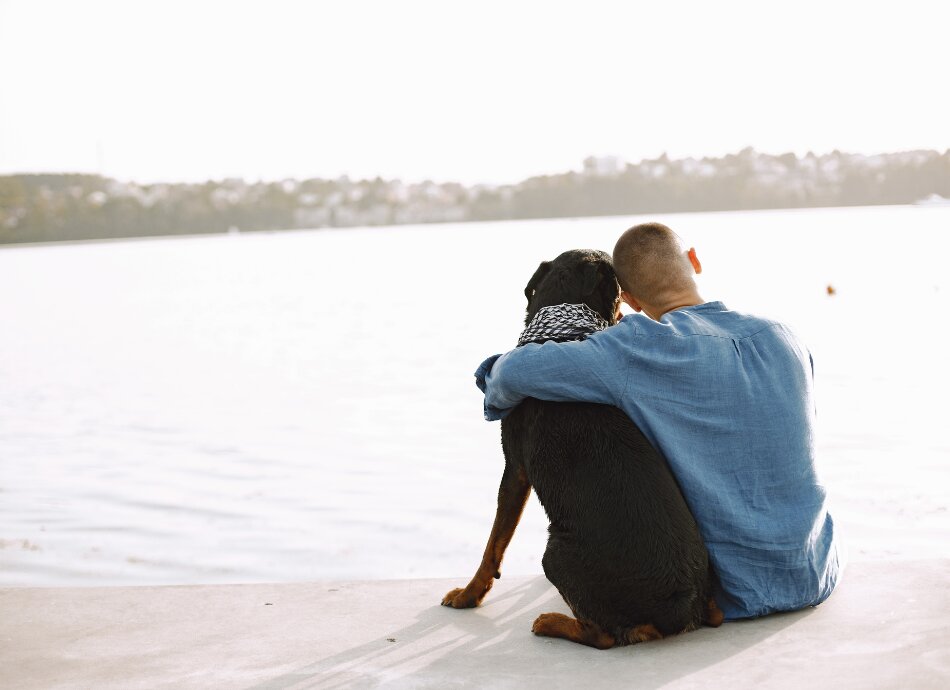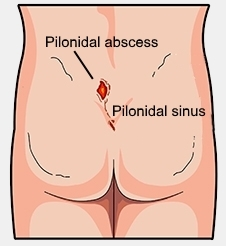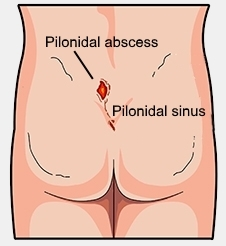Pilonidal disease
Key points about pilonidal disease
- Pilonidal disease is a condition that occurs at the base of your spine in the gap between the top of your buttocks (your natal cleft).
- It happens when hairs burrow into your skin, causing a small nest of hairs that has an opening to the surface of your skin.
- Pilonidal disease can affect anyone but is most common in men.
- If you only have a pilonidal sinus you may not notice any symptoms and may not need treatment.
- If you develop a cyst or an abscess in the area you need to see your healthcare provider for treatment.
- The content on this page comes from HealthInfo(external link).

Pilonidal disease is a condition where hairs burrow into your skin forming a hair nest with an opening to the skin. It usually happens at the base of your spine in the gap between the top of your buttocks (your natal cleft).
Pilonidal disease can affect anyone but is more common in men. It may not cause any problems but may lead to a cyst or abscess that needs to be treated.
It's not known why pilonidal disease happens, but it may be due to having a small dimple in the area or damaged hair follicles that poke into your skin. Once the hairs become stuck in your skin they irritate it, causing inflammation. A cavity can develop in this area called a pilonidal sinus.
your skin. Once the hairs become stuck in your skin they irritate it, causing inflammation. A cavity can develop in this area called a pilonidal sinus.
Image credit: Medical Illustrations, Canterbury DHB
This can form a lump (pilonidal cyst) that isn't painful or red. If this cyst gets infected it becomes a pilonidal abscess.
There are certain situations that make it more likely to happen. These include:
- having curly or coarse body hair in the area around your buttocks
- having a family history of the disease
- being overweight
- poor hygiene
- prolonged sitting or repeated friction to the area causing increased sweating
- certain other skin conditions.
Pilonidal disease can affect anyone but is most common in men. Usually it occurs after puberty and is rare after the age of 40.
When you only have a pilonidal sinus present you may not notice any symptoms, but you might have a small pit or dimple in your natal cleft. You may notice a clear fluid coming from the sinus.
If you develop a cyst, you may notice a small lump, but this isn't usually painful. If you've had the condition for a while it may feel as if there is more than one lump. If you spend a long time sitting, the area may become sore.
If you develop an abscess in the area you may get:
- pain, redness and swelling
- pus, or blood-stained fluid draining from the holes – this may smell bad
- a fever, or feel sick and unwell.
If you have any of these symptoms, it's important to see your healthcare provider and receive treatment.
If you have pilonidal disease without any symptoms you may not need treatment. But it's important to reduce the chance of the condition getting worse.
You can help prevent it getting worse by:
- keeping the area clean
- avoiding tight clothing that increases friction or sweating
- keeping your weight in the normal range for your height
- regularly removing hair from the area
- stopping smoking.
If you have troublesome symptoms with a pilonidal cyst without an abscess, your healthcare provider can refer you to the General Surgery Outpatients Department to see if you would benefit from surgical treatment. There are several types of surgery and your surgeon will give the details and pros and cons of each.
If you develop an abscess with pain, swelling, discharge or fever you need to see a healthcare provider as soon as possible. You'll be referred to a surgeon at the hospital straight away, who will treat the abscess by draining the area. You may be given antibiotics if you're unwell, or have other risk factors such as heart valve disease or reduced immunity.
Having surgery involves some risks, but these are usually outweighed by the benefits. Your surgeon will discuss the likely risks with you. It's important that you take adequate pain relief to manage this while the anal area is healing.
Reference
- Pilonidal disease(external link) HealthInfo NZ
Credits: HealthInfo, NZ
Reviewed by: Healthify Editorial Team. Healthify is brought to you by Health Navigator Charitable Trust.
Last reviewed:
Page last updated:





